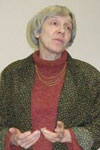
Lomonosov Moscow State University
Moscow
-
Elaboration of Neuropsychological Evaluation of Children: Structural Analysis of Test Results
-
Background. Modern neuropsychology is discussing the possibility of combining qualitative and quantitative approaches in the evaluation of cognitive functions. In Russia a battery of tests called "Methods of neuropsychological assessment for children 6-9 years old" (Akhutina et al., 2016) has been proposed; it is based on the Lurian approach to diagnosis and combines qualitative and quantitative approaches to testing. The present paper describes the development of this combined qualitative and quantitative assessment of various groups of cognitive functions in preschool and primary school children. Structural modeling enables us to analyze a possible combination of integral indices of functions that includes the results of both a face-to-face neuropsychological assessment and computerized testing.
Objective. To develop a combined qualitative and quantitative neuropsychological assessment of children, in order to 1) check the structural reliability of integral indicators of various cognitive functions; and 2) confirm the correctness of combining the results of face-to-face and computerized tests.
Design. A sample of 299 children between the ages of 6 and 9 years old (111 preschoolers, 82 first graders, and 106 second graders) underwent a Lurian face-to-face neuropsychological examination adapted for 6-to-9 year-old children, and five tests from the Computerized Neuropsychological Assessment for 6-9 Year-old Children. The five were the “Dots” test, the Schulte Tables, the Cancellation test, the Corsi Tapping Block test, and the Understanding of Similar Sounding Words test. In each of the tests (face-to-face and computerized), key parameters were identified to evaluate various cognitive functions.
Results. A confirmatory factor analysis verified the composition of the neuropsychological indices that were based on the results of the face-to-face neuropsychological assessment. At the same time, when the computer test data were added to the model, the fit indices of the model considerably improved.
Conclusion. The confirmatory factor analysis confirmed the validity of the identification of eight neuropsychological indices that indicate the component processes underlying complex cognitive functions in children: 1) programming and control of voluntary actions (executive functions); 2) serial organization of movements and speech; 3) the processing of kinesthetic information; 4) the processing of auditory information; 5) the processing of visual information; 6) the processing of visual-spatial information; 7) hyperactivity/impulsivity; and 8) fatigue/slowness.
DOI: 10.11621/pir.2021.0402
Keywords: Neuropsychological assessment/ development of higher mental functions/ primary school students/ cognitive functions/ face-to-face testing/ computer testing
-
-
Understanding of Active and Passive Constructions in 7- to 10-Year-Old Russian-Speaking Children: Reliance on Inflections or Word OrderPDF HTML4663“ CITE
Akhutina, T.V., Panikratova, Y.R., Korneev, A.A., Matveeva, E.Yu. & Vlasova, R.M. (2019). Understanding of active and passive constructions in 7- to 10-year-old Russian-speaking children: Reliance on inflections or word order. Psychology in Russia: State of the Art, 12(1), 3–20.
copied
-
Background. The background of the present study includes analysis of the understanding of active and passive grammatical constructions (GCs) in Russianspeaking aphasic patients and in children aged 3, 4 and 5 years (Akhutina, 1989; Akhutina, Velichkovskiy, & Kempe, 1988). Data regarding the reorganization of the children’s strategies are further compared to GC understanding in children speaking different languages, and their interpretations.
Objective. To analyze the variable mechanisms of understanding of reversible GCs in primary-school-age children, namely, to reveal individual differences in reliance on word order or case endings.
Design. Ninety-three first-graders, 93 second-graders, and 63 third-graders underwent a neuropsychological assessment and computer-based sentence-topicture test of their understanding of reversible GCs of active/passive voice with direct/reverse word order. The “productivity” of understanding GCs (percent of correct responses) was analyzed through cluster analysis.
Results. The cluster analysis divided the children into four clusters. Cluster 1 consisted of eight children with low productivity, who were excluded from further analysis. Cluster 2 was characterized by low productivity in passive direct constructions (Group 1); Cluster 3 comprised children who had low productivity in passive reverse sentences (Group 2). Cluster 4 included children with good understanding of all GCs (Group 3). Between-group differences in productivity and time of correct responses in GCs, as well as neuropsychological indexes, were revealed.
Conclusion. The results are consistent with the following hypotheses: (a) Group 1 relies on the rule “The first noun is the agent”, whereas the other two groups use morphological marking; (b) Group 1 is the weakest neuropsychologically, and syntactic understanding processes involve a more diffuse activation of the brain in this group, compared to more successful children; (c) changes in response times from the first to the second grade are under the influence of cerebral changes induced by reading acquisition.
DOI: 10.11621/pir.2019.0101
Keywords: neuropsychology, individual differences, comprehension, grammatical constructions, children
-
-
L.Vygotsky, A.Luria and Developmental Neuropsychology
-
This article is devoted to Lev Vygotsky’s and Alexander Luria’s contribution to the theory and methods of neuropsychology, and particularly, developmental neuropsychology. The first part of the article covers the principle foundations of neuropsychology as elaborated by Vygotsky and Luria. The goal of the second part is to show what interpretation of learning disabilities can be derived from it.
DOI: 10.11621/pir.2011.0009
Keywords: neuropsychology, cultural-historical psychology, higher mental functions.
-









